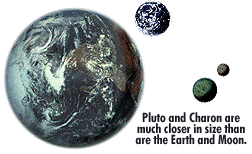Pluto's Companion
 Pluto's
mass was unknown, and was likely to remain so without a breakthrough. That
came on June 22, 1978, when American astronomer James Christy was studying
photographs of Pluto at the U.S. Naval Observatory.
Pluto's
mass was unknown, and was likely to remain so without a breakthrough. That
came on June 22, 1978, when American astronomer James Christy was studying
photographs of Pluto at the U.S. Naval Observatory.
Several images of Pluto were elongated, and the pictures were thought to be defective. However, Christy found other photographs in which the bump on Pluto was in different positions. In fact, he found a series of photographs from 1970 that showed the bump progressing around Pluto in a 6-day period. Christy reasoned that Pluto must have a satellite.
 Christy
proposed the name Charon, after the ferryboat pilot in Greek mythology
who takes the souls of the dead across the River Styx and into Pluto's
realm. Also, his wife's name was Charlene -- nicknamed Char -- and Christy
thus was able to honor her and keep the tradition of naming planets and
moons after characters in Greek and Roman mythology. (Charon, however,
is pronounced in Latin more like "Karen").
Christy
proposed the name Charon, after the ferryboat pilot in Greek mythology
who takes the souls of the dead across the River Styx and into Pluto's
realm. Also, his wife's name was Charlene -- nicknamed Char -- and Christy
thus was able to honor her and keep the tradition of naming planets and
moons after characters in Greek and Roman mythology. (Charon, however,
is pronounced in Latin more like "Karen").
Using the information given to him by Christy, Robert Harrington made an estimate of the satellite's orbit , then used this to compute Pluto's mass. It was the first time astronomers could make a direct calculation like this -- Charon had been the breakthrough they needed. The mass of Pluto was estimated to be just two-tenths of one percent of the Earth. This was significant -- there was no way Pluto could have disturbed Uranus's motion to cause the observed discrepancies.
 Other
discoveries came quickly. Charon orbits 18,800 kilometers above Pluto,
and circles Pluto every 6.4 days, exactly matching Pluto's rotation. Charon
and Pluto are dynamically locked in their orbits, each keeping the same
face to the other (in the same way our Moon keeps the same face to the
Earth). Relative to Pluto, Charon is quite large, being about half the
diameter and one-seventh the mass of Pluto. Before 1978, the Earth and
Moon were the closest thing the solar system had to a double planet, due
to their relative sizes. Now Pluto and Charon hold that honor.
Other
discoveries came quickly. Charon orbits 18,800 kilometers above Pluto,
and circles Pluto every 6.4 days, exactly matching Pluto's rotation. Charon
and Pluto are dynamically locked in their orbits, each keeping the same
face to the other (in the same way our Moon keeps the same face to the
Earth). Relative to Pluto, Charon is quite large, being about half the
diameter and one-seventh the mass of Pluto. Before 1978, the Earth and
Moon were the closest thing the solar system had to a double planet, due
to their relative sizes. Now Pluto and Charon hold that honor.
Charon orbits Pluto in a North-South motion, revealing that Pluto's axis is tipped on its side, in the plane of its orbit. (Earth's axis is tilted 23 degrees to its orbital plane, which is why we have seasons.) In 1980, Charon passed in front of a star, which disappeared for fifty seconds and showed that Charon's diameter is about 1,200 kilometers. In 1985, Charon began a series of eclipses of Pluto that lasted five years. From these, astronomers measured the time it takes Charon to pass in front of and behind Pluto. Result: Pluto's diameter is 2,300 kilometers.
These eclipses began just seven years after Charon was discovered, which was extremely fortunate. The next series of eclipses won't occur until the 22nd century. Had Charon been discovered twelve years later, astronomers would have missed this rare opportunity, and we might still be in the dark about Pluto.